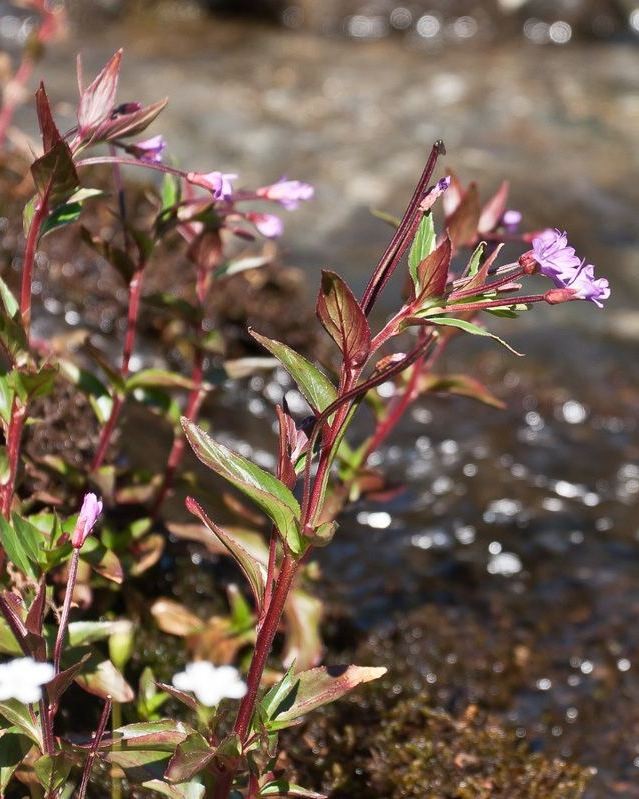Dark-leaved willowherb
(Epilobium lamyi)

Description
Epilobium obscurum, commonly known as the dark-leaved willowherb, is a species of herbaceous perennial plant belonging to the family Onagraceae. This plant is native to Europe and western Asia, and it has been introduced in North America, where it is considered an invasive species in some areas. The name Epilobium comes from the Greek words epi, meaning 'upon,' and lobos, meaning 'a pod.' Description Epilobium obscurum is a herbaceous perennial plant that can reach up to 1.5 meters in height. The stems of this plant are slender and erect, with dark green or reddish-brown leaves. The leaves are lanceolate and have serrated edges, with a length of 5-10 cm and a width of 1-2 cm. The flowers are pink-purple in color and have four petals, forming a loose inflorescence at the end of the stem. The flowering period is from July to September. The fruit is a long and narrow capsule, containing numerous seeds that are dispersed by the wind. Habitat and Distribution Epilobium obscurum is a herbaceous perennial plant that is native to Europe and western Asia. Its natural habitat is damp areas such as wet meadows, streambanks, and ditches. It prefers well-drained soils that are rich in organic matter. Epilobium obscurum has a wide distribution range that includes countries such as the United Kingdom, Germany, France, Italy, Austria, Switzerland, Poland, Russia, Turkey, and Iran. It has also been introduced in North America, where it is found in Canada and the United States. However, in North America, it is considered an invasive species in some areas, where it can outcompete native vegetation and alter the composition of the ecosystem. Therefore, it is important to control its growth in areas where it is invasive. Cultivation Epilobium obscurum is a hardy plant that can be easily grown from seed or cuttings. It prefers full sun to partial shade and moist, well-drained soil. Here are some steps for cultivating Epilobium obscurum: Site selection: Choose a site that has well-drained soil that is rich in organic matter. The site should receive full sun to partial shade. Planting: Epilobium obscurum can be planted in the spring or fall. Seeds should be planted at a depth of 1/8 inch in the soil. The seeds should be kept moist until they germinate, which usually takes around 2-3 weeks. Alternatively, cuttings can be taken in the spring and rooted in moist soil. Watering: Epilobium obscurum prefers moist soil, so regular watering is important. However, make sure not to overwater the plant, as this can lead to root rot. Fertilizing: Epilobium obscurum does not require much fertilization. However, adding a balanced fertilizer once a year can help the plant grow stronger. Pruning: Epilobium obscurum does not require much pruning. However, deadheading the plant after flowering can encourage the growth of new flowers. Caution should be taken when planting Epilobium obscurum, as it has the potential to become invasive in some areas. Therefore, it is important to plant it only in areas where it is not invasive and to control its growth in areas where it is. Medicinal uses Epilobium obscurum has been traditionally used in herbal medicine for its astringent and anti-inflammatory properties. It has been used to treat various ailments such as diarrhea, dysentery, gastrointestinal disorders, and urinary tract infections. Recent scientific research has shown that extracts from Epilobium obscurum have anti-cancer properties and can be used as a natural remedy for prostate cancer. Studies have shown that the plant extracts contain compounds that inhibit the growth of cancer cells and reduce inflammation, which can help to slow down the progression of the disease. Epilobium obscurum is also believed to have antioxidant properties, which can help to protect the body against free radicals that can damage cells and cause disease. However, more research is needed to confirm the efficacy of Epilobium obscurum in treating these and other conditions. As with all herbal remedies, it is important to consult with a healthcare professional before using Epilobium obscurum as a treatment for any condition. While this plant has been used for centuries as a medicinal herb, it can have side effects and interact with other medications. Invasive species Epilobium obscurum has been introduced in North America, where it is considered an invasive species in some areas. This plant can form dense stands, outcompeting native vegetation and altering the composition of the ecosystem. It can also clog waterways and interfere with drainage systems. Therefore, it is important to prevent the spread of this plant by not planting it in areas where it is not native and by controlling its growth in areas where it is invasive. Conclusion Epilobium obscurum is a herbaceous perennial plant that is native to Europe and western Asia. It is a hardy plant that prefers moist habitats and has medicinal uses. However, it can become invasive in some areas, where it can outcompete native vegetation and alter the composition of the ecosystem. Therefore, it is important to prevent the spread of this plant by controlling its growth in areas where it is invasive.
Taxonomic tree:







